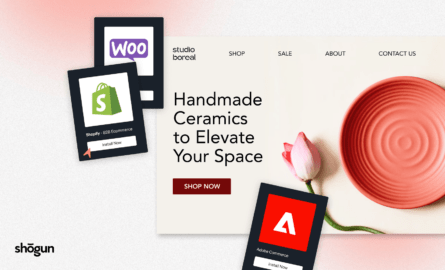The Ecommerce Replatforming Guide: From Migration to Launch

If you're scaling your online store and starting to see considerable increases in traffic and sales, you’ll need a backend commerce platform that can keep pace with your ambitions.
But the replatforming process (going from one backend to another) is not always straightforward, with lots of potential downsides if you get it wrong. There are so many different options to choose from in today’s landscape that the task of overhauling your ecommerce platform for more control might seem daunting.
Nonetheless, replatforming can be necessary to reach your growth potential—so we’ve put together this step-by-step guide to explain how to prepare to migrate an ecommerce website, how to choose the right platform for you, and how to keep your customers happy while you migrate.
Done with good oversight over the steps involved—and often with the right migration partners and platforms—you can skip the headaches and make the whole process smoother.
Here we’ll cover:
- What does ecommerce replatforming mean?
- The challenges forcing brands to migrate
- Examples of brands who’ve successfully migrated
- 11 steps to ecommerce replatforming
- Our handy ecommerce replatforming checklist
Alright, let’s kick it off!
#cta-paragraph-fe#Thinking about taking your store headless? Before or after a replatform, learn how you can get ultimate control and flexibility of your frontend, the easy way. Learn more
Put simply, replatforming means moving your ecommerce site, data, catalogs, and products from one backend commerce system to another one better suited to your stage of growth.
Replatforming has traditionally been associated with huge costs and long lead times. It’s not something that you should go into lightly or without doing your due diligence, but—thanks to emerging tech—it doesn’t have to be the massive challenge it once was.
With headless solutions, replatforming, while not exactly a breeze, is a lot more straightforward now that there are a host of third-party providers available to take some of the technical burdens off your hands.
Why do brands typically replatform?
As Isaiah Bollinger, Chief Executive Officer at full-service ecommerce agency Trellis shares with us:
"Most brands are forced to consider a migration for a handful of reasons. The simplest is that their [existing] platform has become end of life. This is like Magento 1 EOL or Infor Storefront, in which the platform itself and ecosystem around it, has moved on to a newer technology. Now you have to migrate. This usually opens up the door for people to consider all options.”
“…The second reason is that their platform is simply old and outdated. This could be an old custom code base, an old version of Oracle platform, or one of the legacy platforms like Miva that just hasn't kept up with the times like Shopify or BigCommerce. In this case they are simply looking to upgrade their old platform to something better.”
“[And] the last reason would be that they simply have outgrown their platform or see an opportunity to make more money on a better platform. This could be something like outgrowing WooCommerce which isn’t very good for scaling to large order volumes. In some cases they may need a new design and in that case it might also make sense to look at upgrading to a better platform in that process.”
How does headless come into play with replatforming?
During replatforming you often need to redesign your entire frontend, because what you built in Shopify doesn't translate over 1:1 to BigCommerce, Magento, and vice versa. So it's a great time to also go headless because you’re often likely working with an agency partner to rebuild your frontend anyway.
What’s more—if you build your headless store especially well, you may not need to deal with the hassles of migration again for a very long time. This because your code should be easy to migrate.
Going headless with a replatform is thereby also an opportunity to jump ahead of the competition.
Afterall, you wouldn’t be looking into replatforming your tech stack if you didn’t feel there was a pressing need to improve or scale some aspect of your ecommerce game, so make sure the time, money, and effort go to good use. If you approach ecommerce site migration with your ducks in a row, you’ll end up with a system capable of delivering the shopping experiences you need to make a lasting impression on your customers. And you can set yourself up for long term success.
The benefits of replatforming headlessly
If you’re currently using a monolithic commerce platform (where your site and the frontend presentation layer are entirely dependent on and connected to the workings of your backend ecommerce services), replatforming to a solution that supports headless commerce will ensure you can keep up with the needs of modern online retail.
#cta-paragraph-fe#Headless commerce simply means that the front and backend of your store become separate instead of fused together. This ultimately grants more flexibility over how you manage your frontend layer.
If you need to add extra UX and performance functionality that doesn’t come as standard with your commerce platform of choice, you can much more easily integrate commerce services with a headless setup.
Often going headless will also future-proof your business, as you can incorporate extra features or dynamic shopping down the line, avoiding the need to go through another costly replatforming process later on. Some emerging ecommerce brands are taking their stores headless very early in their growth trajectory for this reason.
As Joe Tao, Daring Foods’ former Head of Platform & Delivery shares, their brand wanted to go headless very early to combat commoditization in the market, and to avoid additional replatforming discussions later:
“While going headless may have been a bit early for us, we knew we were going to go in this direction at some point. We decided to invest now instead of having to build another site later.We were confident that going headless would allow us to scale as we grow."
So why are so many ecommerce brands considering their back and frontend technology? As ecommerce continues to grow rapidly, brands are having to re-think their strategy to accommodate the needs and expectations of customers.
There are several pain points for online brands working with outdated ecommerce platforms—or as they simply outgrow platforms, including:
Sub-standard customer experience + performance
If your site is slow to load, hard to navigate, and has a sluggish checkout function, shoppers will notice and go elsewhere. Trying to iteratively improve site performance and navigation while working within the constraints of legacy ecommerce platforms can only get you so far. Today’s brands are looking for more long-term solutions to meet shopper expectations.
The need to integrate multiple channels
Multichannel and omnichannel retail has brought with it the need to hook up multiple touchpoints to a single backend system. This can be an all but impossible task if you don’t have the right platform in place.
High cart abandonment rate
If the cart service on your commerce platform struggles to keep up with increased traffic, it will hit your sales hard. Switching to a new platform with greater capacity will keep you maximizing revenue.
Clunky admin panels
It’s not just your customers who will notice if your ecommerce platform isn’t up to scratch, your internal web teams will also find it hard to design and deliver the experiences expected in modern online retail if they’re working with UIs designed for a different era. You need your ecommerce team to be able to quickly make site changes to impact revenue, and older platforms or UI can slow you down here.
It’s hard to add new functionality
Adding new features to an old system can be cumbersome. With an updated, headless commerce platform, putting together disparate services and extensions is made much simpler.
#cta-paragraph-fe#When do you know it’s time to replatform (and also go headless)? There are symptoms that arise as you scale that are clues it’s time to make the move. Learn about the signs it’s time to go headless
Why you'll wish you replatformed sooner
While replatforming may feel like an overwhelming task to startup, there are opportunity costs in not acting.
As the ecommerce world embraces newer, headless solutions, being tied to a monolithic platform will see your competition pull ahead of you. You need to be agile, and a frontend separate from your backend platform can really make a difference in the promotions you can get up to impact revenue, faster.
Without ecommerce site migration as you scale, you won’t necessarily be able to take advantage of:
Faster site speeds
Outdated backend systems have a serious impact on site performance. Updating to a new, headless system will free your frontend site from the need to run browser requests through the backend system and drastically improve performance.
As Savannah Sachs, CEO of TULA, says of their brand’s choice to move to a headless architecture:
“Rather than relying on Shopify Plus for that front-end experience, the way we have in the past, we wanted to innovate and build in-house using our digital and tech teams. Speed is incredibly important and is one of the biggest reasons we have gone headless. By building our own frontend, we can really optimize speed and the shopping experience. How quickly your website loads, and how fast your customer can navigate through it, is a huge determinant of performance.”
#cta-paragraph-fe#Learn how TULA Skincare took control of their destiny and sped up page to page load time by 5X by replatforming.
Enhanced customer experiences
Creating a continuous, smooth, and integrated customer experience is extremely hard to do with monolithic commerce systems. New commerce platforms can support several channels at once, irrespective of the frameworks they operate in. It means your teams can finally design the elevated experiences your customers need and push them to multiple channels without coding these changes.

Advanced personalization opportunities
Today’s commerce platforms have incredibly powerful tools to gather, analyze, and action customer data. It means brands can create highly personalized interactions that are not possible in lower capability systems. Now, better site speed and dynamic UX design—something that felt like an either/or situation before—are both possible at the same time when brands change ecommerce platforms.
Astrid & Miyu, a UK jewelry brand, migrated from a monolithic commerce platform to Shopify Plus, a headless-enabled solution. They needed to move to accommodate their growth in traffic.
Their main focus was to keep their SEO and organic traffic stable during the transition, which they did by conducting a thorough SEO audit and making a detailed, point-by-point ecommerce site migration plan.

The Upside, an Australian sportswear brand, migrated to BigCommerce to reduce onerous maintenance requirements that were a drag on costs and their technical teams’ time. They wanted to be able to add features to their online store without the technical headaches and to gain flexibility over how they developed their site. After they migrated to BigCommerce, they saw a 103% jump in conversion rates and a huge 161% increase in revenue.

#cta-paragraph-fe#See examples of ecommerce site migrations to a headless setup. From Thomas Kent to Oliver Bonas, Jenny Yoo, and more—see the brands also making the leap to headless for greater flexibility.
Now we’ve looked at the reasons why you should think about replatforming your ecommerce website, it’s time to walk through how it’s done.
Taking things one step at a time will see you avoid mistakes in what can be a highly complex process if you’re unprepared. If you have a great agency partner to make the move with—you can mitigate stumbling blocks and ensure a more pleasant migration for all involved.
Step 1: Make a detailed list (or three)
This first step involves creating a detailed document with three parts:
- List all the store functionality you already have and need to keep. This includes everything from discovery to checkout—including any existing one-click integrations you might be using and want to fully integrate into your new customer experience.
- List all the enhancements you’ll need and make a note of the gaps in your ecommerce services.
- Calculate all the costs involved – including labor costs, ongoing contracts with vendors, and other transition costs.
This is a crucial step as when you do replatform, you need to make sure all your functionality is still going to be supported, as well all the newer enhancements you need.
Creating this document should involve all the teams that work on your current set-up, technical, business, and marketing. You should use this opportunity to get input on your teams’ needs and any improvements in processes and workflow that they can identify, as well as the more technical improvements and specifications required from your new platform.
If you’re moving to a headless platform, you can reassure stakeholders that you don’t need to do a rip-and-replace replatforming but can do it in stages.
#cta-paragraph-fe#What can you expect in the headless implementation process? Go behind the build with Shogun Frontend to learn what to expect in each step along the way.
Step 2: Get everyone onboard
Consulting your teams at the outset will go a long way to achieving this, but you might find some conflicting interests along the way.
For example your content editors may want to replatform so that they may more easily edit content throughout the site, but the order management team may be concerned about retraining staff to use a new ecommerce platform. (in this specific instance a headless solution may be better fit than a total replatform).
Identifying any potential issues early on and thinking through how you can resolve them before you re-platform will save you a lot of stress down the line.
Step 3: Draw up a shortlist
Once you know what your requirements are, you’re in a position to start checking them off against the features provided by ecommerce platform vendors.
At this stage, you can start properly considering whether to go for a self-hosted, cloud-based, or SaaS solution.
The main features of each type are:
- Self-hosted – You host the ecommerce solution yourself. It means that you don’t have to rely on anyone else to set up and maintain your platform, which brings greater control. But it also brings with it greater responsibility. Unless you’re fully set up with big technical teams, you may not be able to support all the functionality you need. At first sight, it might seem like a cheaper solution, but you have to factor in maintenance and oversight costs, which are ongoing.
- Cloud-based – Your servers are maintained by a third party, giving you access to their infrastructure. But you still have control over and responsibility for maintenance and updates.
- SaaS – A third-party specialist hosts and maintains the platform for you, taking care of security, updates, and patches. It means that you’ll be giving up some control on when to make updates, and you’ll lose visibility into the more granular, technical aspects of the platform. But this is made up for by the oversight and expertise you’ll be getting access to, and it will take a big responsibility off your hands, letting you focus on the core of your business.
The option you go for will depend mainly on the size of your business. For larger brands, it might make sense to self-host, although many big companies are moving to a cloud model due to the infrastructure it provides.
For many scaling brands, a SaaS solution will be the best fit, it means you can buy into top-end know-how that is beyond the scope of your business.
Whatever option works best for you, you should consider if and how it supports headless commerce. As headless offers much greater speed, flexibility, and potential to create outstanding customer experiences, using your replatorming process as an opportunity to move to a headless model will future-proof your brand.
Step 4: Try before you buy
Shortlist of frontend platform providers in hand, you’re now at the stage where you can test out the technology for yourself. Vendors will be more than happy to arrange a demo for you, so take the opportunity to find out what the integration requirements are, how you should get ready, and how long the migration will take for each vendor on your list.
Consider in this phase as well how each vendor accounts for data management in your replatform. That is—is this a managed service as you migrate? Does the company have specialists to manage your data integrity and analytics migration onboard? Is this part of the implementation or something you’ll need to set up on your own? This will be critical as you measure the ROI of your migration.
Step 5: Choose a platform
You’ve done your homework, got all your internal stakeholders on board, and tested the waters with potential solutions. By now you should know what platform will best meet your needs. It’s decision time! Select your platform, get your contracts in order, and begin the prep and discovery phase with your implementation team.
Step 6: Select a site migration agency partner
In parallel with step four and five, major retailers and scaling brands often select an agency partner for implementation. Agencies are at the forefront of new ecommerce platforms, and often have the in-house infrastructure and expertise to accelerate your migration to a new platform. Working with certain vendors, they may also go through certification programs in building headless sites, for example.
If you want to speed up your time to value, agency partners may help you realize your new store vision faster, and are experienced in taking on replatforms for other brands. You can gain significant advantages by partnering with an agency and benefit from the resources they have to ensure all steps of your migration are covered.
#cta-paragraph-fe#See how brands are teaming up with agencies for terrific results when replatforming their sites to a headless architecture.
Step 7: Pre-migration checks and balances
Before you start the re-platforming process, you need to make sure all your customer data, catalogs, and current ecommerce functionality will be preserved in the move. You’ll also want to minimize disruption to customers and downtime, so a solid pre-migration plan is essential.
As mentioned above, data migration is the most important thing to get right. Make sure you know exactly where your data is currently stored, whether you’ll have access to it during migration, and where it will sit in the new platform.
Even when you’ve got a detailed plan for your data migration, you should still make sure you back-up everything. Moving large amounts of data from one place to another is a tricky process, and things do sometimes go wrong.
Step 8: Migrate your data
Most brands of moderate size and above will benefit from the help of a data migration specialist, some of the most popular services are:
Alternatively, your platform provider might offer a data migration service, so you should check with them if it is included in the ecommerce migration package.
Whichever option you go for, the pre-migration data plan will help you avoid some costly pitfalls:
- Loss of data
- Incorrectly mapped products
- Incorrectly displayed prices
- Degraded personalization capabilities due to poorly synced customer data
- Negative impact on customer experience due to parts of your site not working, or not working properly (mismatched product images and incorrect pricing, for example.)
Step 9: Setup checkout
After data migration, optimizing the customer experience at checkout is the next big thing to focus on. As this is a core function of any ecommerce platform, and of any online store, making it smoother, faster, and more reliable than the one you currently have is important.
If you’re going for a headless commerce platform, you can easily integrate checkout functionality from third-party ecommerce migration services, so if you’ve decided on a great platform but you need some special customizations to handle your checkout process, you can talk this through with your vendor and either develop a solution with them or add-in functionality from another provider.
Step 10: SEO and site redesign
This is another step that will be made a lot easier if you’re using headless commerce. If you’re coming from a monolithic platform where the frontend of your store was bound up with your backend commerce functions, going headless is a chance to redesign your site and channels.
The flexibility that headless provides means you can do this separately from platform migration, but now you don’t have to worry about re-coding frontend changes, your marketing and business teams can easily make design and layout alterations so you can have a new frontend site to match your improved backend functionality.
#cta-visual-fe#<cta-title>Scale effectively: Take your store headless the easy way<cta-title>Learn how Shogun Frontend can help you achieve the exact ecommerce experience you envision. Learn more
But a word of warning: whilst moving from a monolithic to a headless platform will make site changes much easier, you shouldn’t make too many changes at the same time as migration. It can harm your SEO rankings if you change too many things at the same time. Your domain authority will likely decrease slightly in the period directly after migration, so it’s best to tackle these things separately.
Instead, focus on setting up 301 redirects from your current product pages to your new ones, make sure you conduct a thorough SEO audit before migration, and monitor your new set-up for page-load errors.
Step 10: Test before takeoff
If you’re following the steps in this guide, you’ll already be aware of the importance of preparation. Before you launch your new platform, perform thorough tests to see if you can add to cart, complete a purchase, and walk through any and all custom features to make sure everything is working as expected. It’s much better to catch an error at this stage than have it impact your customers.
Step 11: Launch your new platform
When you’ve completed all your tests satisfactorily, you’re finally ready to launch your newly migrated site.
To minimize potential disruption, you might want to re-launch at a time of low traffic, in the early hours of the morning, for example.
When you have launched, continue to monitor and test your site for errors. Getting everything right in a test environment doesn’t necessarily inoculate you from mishaps in the real world. Migrating commerce platforms is a complex process and you shouldn’t expect everything to go exactly to plan but as long as your teams are on top of any issues, you’ll be able to keep things like 404 errors and page mis-directs to a minimum.
Congratulations! You’ve successfully migrated to a new and improved commerce platform.
To help you follow the step-by-step guide, here’s our practical checklist to keep in mind while you work through the replatforming process:
- Create a comprehensive pre-replatforming document listing all current store needs, any gaps in desired functionality, and what you’ll need for the future. Pertinent things for consideration in this step include:
- One-click to install integrations you already have on Shopify
- Ensure buy-in from all your teams, and keep the lines of communication open throughout the process.
- Research your replatforming options: checkout, site speed, enhanced SEO, advanced personalization capabilities, frontend flexibility, and ease of access for non-technical teams are some of the must-haves.
- Consider an implementation partner: Peruse the options you have available for an agency partner to help with your implementation. Check out the best ecommerce web design agencies available, view their portfolios and case studies to understand their capabilities for taking stores headless.
- List all the costs, both initial and ongoing maintenance, so you know what the total cost of ownership will be and can make the pitch to your internal stakeholders and secure budget.
- Data migration: Back up all your data and create a map of where it is now, what parts of it you’ll have access to during migration, and where it will end up in the new platform.
- Perform an SEO audit.
- Test how your checkout service works on the new platform – do you need extra functionality?
- Test your pages – are they redirecting properly? Are your products displaying correctly?
- Work out the best time to launch. Minimize disruption and downtime.
- Decide on the best time to redesign your site to take advantage of your new capabilities.
- Monitor your site closelypost-launch and for a period after to compare results.
Replatforming or migrating platforms opens up new possibilities
Changing ecommerce backend platforms is not always an easy task and may feel all but impossible to do without causing lots of disruption for your customers and teams.
But, done the right way, with a proper plan in place and a map of how you’ll get there, migration doesn’t have to be a huge burden.
Further, if you replatform backends, and also use this migration to get a headless frontend as well, this can be a great time to make that extra swap too:
“Going headless is not as intimidating or complex as it seems. With Shogun Frontend, you get a complete understanding of the build process from start to finish and have a team in your corner to help at every part of the process.” — Joe Tao, Head of Platform & Delivery, Daring
Using a replatform to go headless also opens up a world of possibilities in terms of site speed, functionality, and customer experience that would be unavailable to you when working with a monolithic, legacy platform.
If you’re thinking of replatforming (and moving to a headless frontend in the process), Shogun Frontend provides the tools to create breathtaking frontend experiences, free from many of the technical hurdles required from monolithic commerce, or an entirely bespoke solution.
#cta-visual-fe#<cta-title>Exceed limits by taking your store headless<cta-title>Learn how Shogun Frontend can help you achieve the exact ecommerce experience you envision. Learn more

Rhys Williams
Rhys is a writer specializing in enterprise software, ecommerce, and SaaS. He describes himself as a geek and a wordsmith and relishes making complex, technical topics come to life in easy-to-understand web copy.



